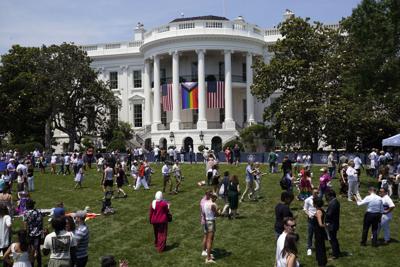WASHINGTON 鈥� President Joe Biden welcomed hundreds to the White House on Saturday for a delayed Pride Month celebration aimed at showing LGBTQ+ people that his administration has their back at a time when advocates are warning of a spike in discriminatory legislation, particularly aimed at the transgender community, sweeping through statehouses.

People walk on the South Lawn of the White House during a Pride Month celebration Saturday in Washington.聽
The event, which the administration described as the largest Pride event hosted at the White House, was initially scheduled for Thursday, but was postponed because of poor air quality from hazardous air flowing in from Canadian wildfires. But the haze that blanketed a huge swath of the East Coast this past week had lifted over the nation's capital, allowing the president and first lady Jill Biden to hold their South Lawn party.
12 important moments in the history of the gay rights movement
Early organizing
Updated
In 1924 the Society for Human Rights was founded by Henry Gerber in Chicago. It was the first documented gay rights organization in the United States, and meetings were held in his home.
The Henry Gerber House, pictured, is now a National Historic Landmark.
Talking about transgender
Updated
Christine Jorgensen, a former U.S. Army private, made headlines in the 1950s after having sex reassignment surgery and talking widely about her experience, one of the first people in the U.S. to do so. Her gender conversion began with hormone injections in 1950, when she was 24, and was completed in 1952 with surgery at the Danish State Hospital in Copenhagen.
On the front lines
Updated
Barbara Gittings, pictured at a rally, was a prominent gay and lesbian rights activist who, a decade before the Stonewall rebellion of 1969, was battling for the rights of homosexuals.
In the late 1950s she founded the New York chapter of the Daughters of Bilitis, the first national organization for lesbians, The New York Times reported.
In the early 1970s she helped lobby the American Psychiatric Association to change its stance on homosexuality; in 1973 the association rescinded its definition of homosexuality as a mental disorder.
Fighting back
Updated
Early on June 28, 1969, New York police raided the Stonewall Inn, a gay club in Greenwich Village. The raid set off a riot among bar patrons and neighborhood residents as police roughed up customers, leading to six days of protests and clashes with police.
The Stonewall riots were a defining moment for the nascent gay rights movement and the reason behind June being chosen as Pride Month.
PFLAG is started
Updated
The idea for PFLAG, which originally stood for聽Parents and Friends of Lesbians and Gays, began in 1972 when Jeanne Manford marched with her son, Morty, in New York's Christopher Street Liberation Day parade, the precursor to today's pride parades. In March 1973 the first meeting of what would become PFLAG was held.
The group went national as Parents, Families and Friends of Lesbians and Gays in 1982. Since 2014, PFLAG is no longer considered an acronym but rather the entire name of the organization.
Pride parades are born
Updated
The first pride parade was held in New York on June 28, 1970, one year after the Stonewall raid on Christopher Street. A few thousand people took to the streets in New York, and gay activist groups on the West Coast held a march in Los Angeles and a march and gay-in in San Francisco. In Chicago people marched the day before New York and marked the Stonewall anniversary with a week of events.
365bet体育在线世界杯, millions around the world march and rally for LGBTQ pride around the world, including in West Hollywood, pictured, which has one of the biggest and best-known pride events in the country.
Winning elected office
Updated
Gays and lesbians also made strides in the 1970s by running for office. Kathy Kozachenko became the first openly LGBT American elected to public office when she won a seat on the Ann Arbor, Mich., City Council in 1974. Elaine Noble was the first openly gay candidate elected to a state office when she was elected to the Massachusetts legislature, also in 1974.
And Harvey Milk won a seat on the San Francisco Board of Supervisors in 1977. Milk was loud and unapologetic about his sexuality, earning widespread attention. His remarkable career was cut short when he was gunned down about a year after taking office.
Pop culture representation
Updated
Billy Crystal, pictured in 1998, played one of the first openly gay characters in a recurring role on a prime-time television show on "Soap," which ran from 1977 to 1981.
Making noise
Updated
Writer and AIDS activist Larry Kramer's work with ACT UP and the Gay Men鈥檚 Health Crisis brought attention to the AIDS crisis at a time when many people preferred ignorance. He loudly demanded attention for the disease that was felling thousands of gay men, and his writing, including the play "The Normal Heart," captured the ordinary lives caught up in the ordeal of AIDS.
Political action
Updated
The Democratic Party added 鈥渟exual orientation鈥� to its platform鈥檚 anti-discrimination protections at the 1980 convention in New York. It was the first American political party to officially incorporate such a plank. Jimmy Carter and his running mate, Walter Mondale, along with their wives, are pictured at the convention.
Same-sex marriage
Updated
In 2004 Massachusetts became the first state to make it legal for same-sex couples to wed. It followed a controversial decision from the Massachusetts Supreme Judicial Court.
Nooni and Alicia Hammarlund, pictured, were among the couples securing a license on May 17, 2004, the first day for legal marriages.
Supreme Court ruling
Updated
On June 26, 2015, the U.S. Supreme Court ruled by a 5-to-4 vote that the Constitution guarantees a person's right to same-sex marriage.
鈥淣o longer may this liberty be denied,鈥� Justice Anthony M. Kennedy wrote for the majority in the historic decision.







































